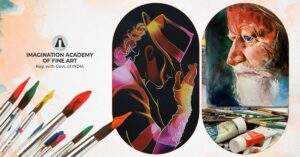Drawing with charcoal is a highly gratifying process. It might be because charcoal paintings are so quick to finish and produce instant results, or because the end result is so spectacular. People adore charcoals in any case. Michelangelo himself developed a collection of charcoal sketches. However, there are several charcoal painting tips one should be aware of before commencing on their first masterpiece.
To experiment with these charcoal painting tips, you can use any sort of charcoal. Simply inquire at your local art store, and they will assist you. If this encourages you to continue your learning, visit Imagination Academy of Fine Arts to find courses, seminars, and more.
Today, we walk you through some essential charcoal painting tips and tactics to help you get started successfully. So, adhere to the success-oriented instructions below and watch yourself grow into an amazing artist.
• Find the Essence
The most important thing is to preserve the most important item as the most important item. The Academy of Fine Arts explains the essence as the primary item (the most important item). And, it is just as crucial in charcoal painting as it is in any other media. When producing an artwork, it’s important to decide what the picture is about and what you want to convey. Once you’ve decided on the “primary concept” or the core of the piece, everything you do thereafter—every action and every element you include or omit—should serve to bolster that theme.
• Understand the Significance of “Value”
The term “value” is frequently used in the arts and can be perplexing. Value is just a stroll from white to black (light to dark) on a scale of one to ten. One represents the white of the page and ten represents black, therefore a five, 50% or ‘halftone’ is a medium grey that is halfway between white and black.
Regardless of color, every image is made up of values (dark or light). So, always work from the center by maintaining your deepest dark (the shadows) no darker than a value of six or seven and your brightest light (the light effect or everything in the light) no lighter than a value of three or four. Then, work your way up to the darks (accents) and whites (highlights).
Consider accents and highlights to be twins living in separate parts of town. Although they are not the most significant aspect of your appearance; they serve the greater good.
• Make Use of the Value Hierarchy
It’s reasonable to assume that an effective image is one that is read swiftly and has the ability to move you emotionally. Using value or tone and allocating different portions of your charcoal painting to lighter or darker tones may be a very useful technique.
Plus, using a hierarchy of values helps you to guide the viewer’s attention to what you want them to see first.
• Explore Thick and Thin Lines
The use of thick and thin lines is an intriguing concept, and it is amazing how many artists overlook this quite useful approach in their work. If every line in a charcoal painting has the same width or is done with the same precise pressure, it looks like a coloring book drawing and may be quite tedious and uninteresting. Using thick and thin lines in your drawing will bring it to life.
So, how do you employ this strategy, and what information do you require? Lines on top of things are thinner because the light is striking them, but lines beneath items are larger because shadows are frequently present. That’s all. Isn’t it simple?
• Make Use of an Eraser
The great thing about charcoal is that it is simple to regulate. It is lightweight and portable. After applying charcoal, you can remove it or erase it from areas where it is no longer needed.
• Equip Yourself with a Few Tools
Traditional artists have a wide variety of instruments to pick from. In fact, the equipment for making charcoal drawings are particularly fascinating and helpful when it comes to tough heavy lifting erasing operations.
• Always Wear a Glove
Do you ever realize that the oils on the surface of your palm might harm the purity of your paper or stock and work against you? The oils on your palm might even adhere to the paper and reject the medium. So, always wear a glove or lay another piece of paper beneath your hand to safeguard your artwork.




